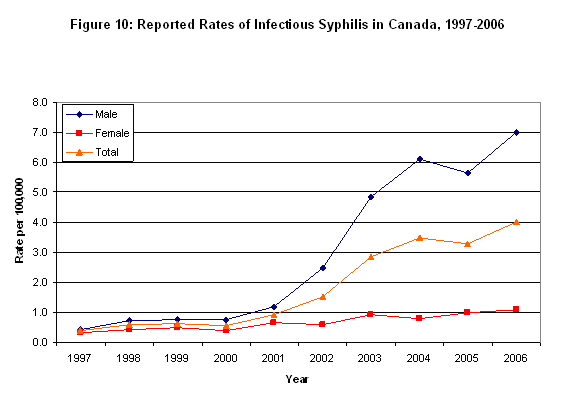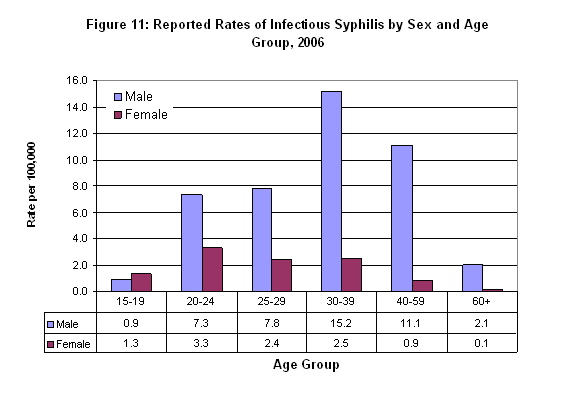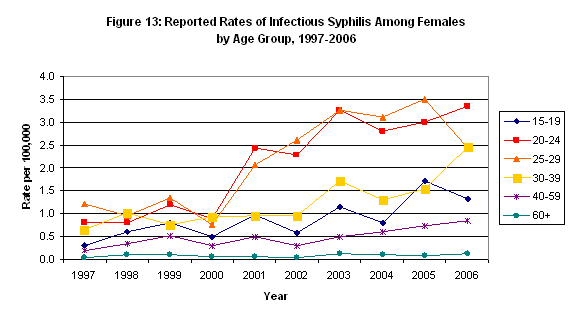Common menu bar links
Institutional links
Diseases & Conditions
Health & Safety
Research & Statistics
Agency Information
Search Box
E-mail this page
Brief Report on Sexually Transmitted Infections in Canada: 2006
[Previous] [Table of Contents] [Next]
Syphilis (Treponema pallidum)
Syphilis, nationally reportable since 1924, progresses through different stages of infection. Primary, secondary and early latent (< 1 year) syphilis, which are the most infectious stages of syphilis, are included in national reports. Untreated syphilis will enter into a late latent stage of the infection that may lead to serious complications associated with tertiary syphilis. This includes damage to the central nervous system, cardiovascular system, eyes, skin and other internal organs. Untreated syphilis can be fatal1 . Individuals infected with syphilis are at an increased risk of contracting and transmitting HIV2 .
The reported rate of infectious syphilis is increasing in Canada, particularly among males.
- In 2006, 1,311 cases of infectious syphilis cases were reported to PHAC, corresponding to a rate of 4.0 per 100,000 (Figure 10). The overall rate in 2006 increased by 21.2% from 2005 (3.3 per 100,000 population) and by 900% when compared to 1997 rates (0.4 per 100,000 population).
- Historically, a greater number of cases have been reported among men than women. This trend continued in 2006, when males accounted for 86.3% of reported cases (1131 cases among males versus 180 cases among females).
- Between 1997 and 2006, outbreaks of infectious syphilis were reported across Canada, including Vancouver, Edmonton, Calgary, Winnipeg, Toronto, Ottawa, Montreal, and Yukon4-12.
- The reported rates of infectious syphilis have increased among both males and females with a larger increase noted among males. Between 2005 and 2006, the reported rates of infectious syphilis among males increased by 25% (from 5.6 to 7 per 100,000) (Figure 10). During this time, the rate among women increased by 10% (from 1 per 100,000 to 1.1 per 100,000) (Figure 10). Between 1997 and 2006, reported rates increased 1,650% among males (from 0.4 to 7 per 100,000) and by 233.3% among females (from 0.3 to 1.1 per 100,000).
- Between 1997 and 2006, there was an increase in the male-to-female ratio in the reported rates of infectious syphilis from 1.3:1 in 1997 to 6.3:1 in 2006.

Higher numbers of infectious syphilis cases are reported among the older populations, particularly males.
- Unlike chlamydia and gonorrhea, in 2006, reported cases of infectious syphilis were mainly among older males (≥ 30 years).
- In 2006, the highest reported rate of infectious syphilis was among males aged 30-39 years at 15.2 per 100,000 (Figure 11), accounting for almost one-third of all reported cases of infectious syphilis among males.

- Between 1997 and 2006, the reported rate of infectious syphilis in the 30-39 age group of males increased by 1,420% (from 1 to 15.2 per 100,000) (Figure 12).
- The corresponding increase among females in this age group was 257.1% (from 0.7 to 2.5 per 100,000) (Figure 13).
- Among females, reported rates were highest among the 20-24 year age group at 3.3 per 100,000 (Figure 13).
- Infectious syphilis can be transmitted from a mother to her child during pregnancy or delivery, leading to fetal death or congenital syphilis.
- In 2006, there were a total of seven congenital syphilis cases reported from British Columbia, Alberta, and Ontario, corresponding to a rate of 1.97 per 100,000 live births.


The majority of reported cases are concentrated in Canada’s most populous provinces.
- In 2006, the highest reported rate of infectious syphilis was in British Columbia followed by Alberta (Table 3).
- Between 1997 and 2006, the largest increases in reported rates of infectious syphilis were in Quebec and Alberta.
- In Quebec, between 1997 and 2006, the reported rate of infectious syphilis among males increased 9500% (from 0.1 to 9.6 per 100,000) compared to a 100% increase among females (from 0.1 to 0.2 per 100,000) during this same time period.
- In Alberta, between 1997 and 2006, the reported rate among males increased 4300% (from 0.2 to 8.8 per 100,000), compared to a 1200% increase among females (from 0.3 to 4.0 per 100,000) during the same time period.
Table 3. Reported Cases and Rates of Infectious Syphilis by Province/Territory, 1997 and 2006
| Jurisdiction | Number of cases | Rate per 100,000 | Rate change1 1997-2006 (%) | ||
| 1997 | 2006 | 1997 | 2006 | ||
| NL | 0 | 0 | 0.0 | 0.0 | 0.0 |
| PE | 0 | 0 | 0.0 | 0.0 | 0.0 |
| NS | 1 | 2 | 0.1 | 0.2 | 100.0 |
| NB | 0 | 0 | 0.0 | 0.0 | 0.0 |
| QC | 7 | 367 | 0.1 | 4.8 | 4700.0 |
| ON | 49 | 361 | 0.4 | 2.8 | 600.0 |
| MB | 0 | 15 | 0.0 | 1.3 | * |
| SK | 2 | 17 | 0.2 | 1.7 | 750.0 |
| AB | 7 | 218 | 0.2 | 6.5 | 3150.0 |
| BC | 49 | 331 | 1.2 | 7.7 | 541.7 |
| YT | 0 | 0 | 0.0 | 0.0 | 0.0 |
| NT2 | 0 | 0 | 0.0 | 0.0 | N/A |
| NU2 | N/A | 0 | N/A | 0.0 | N/A |
| Canada | 115 | 1311 | 0.4 | 4.0 | 900.0 |
| 1 Rate change calculated using unrounded values. |
|||||
[Previous] [Table of Contents] [Next]
